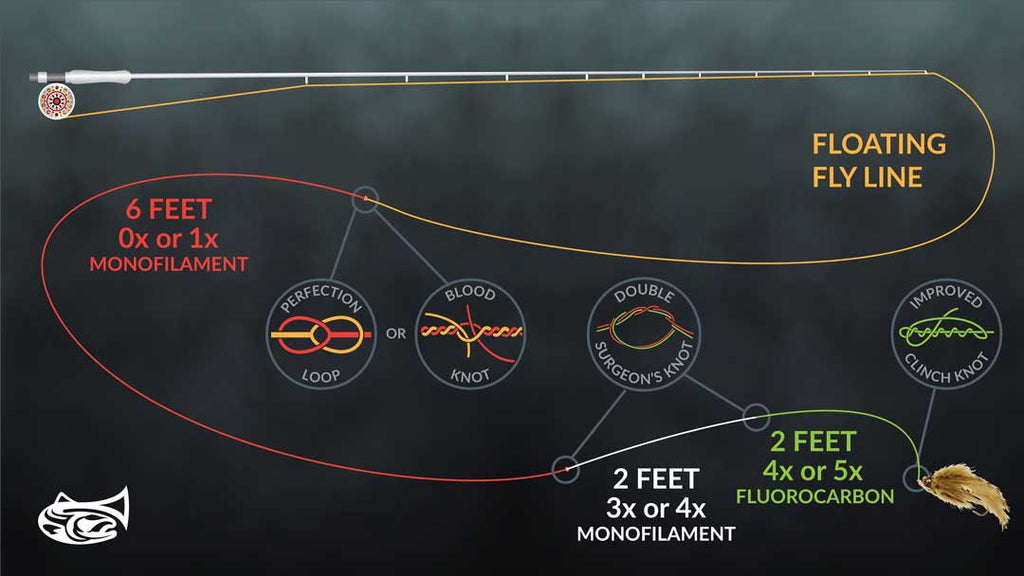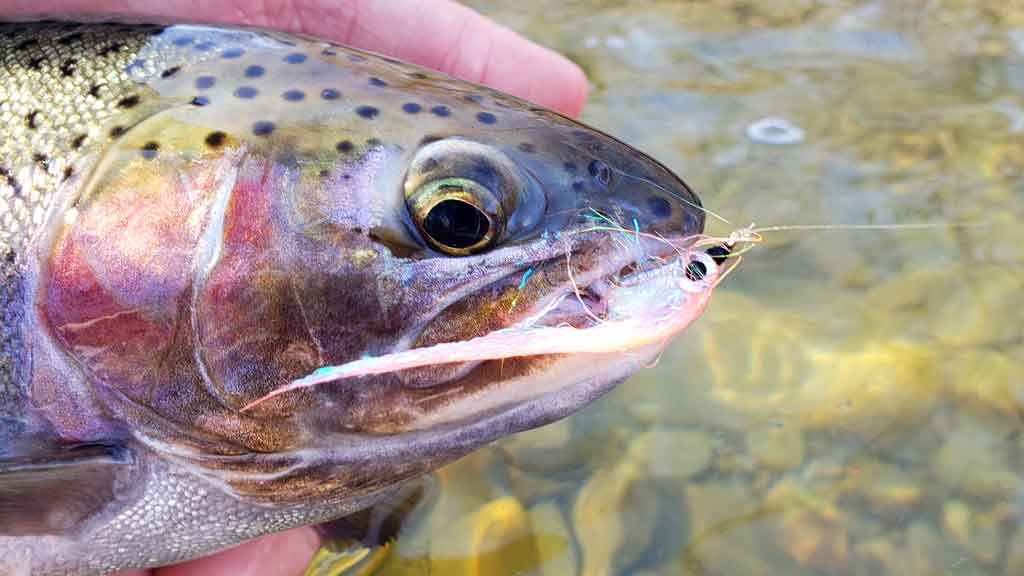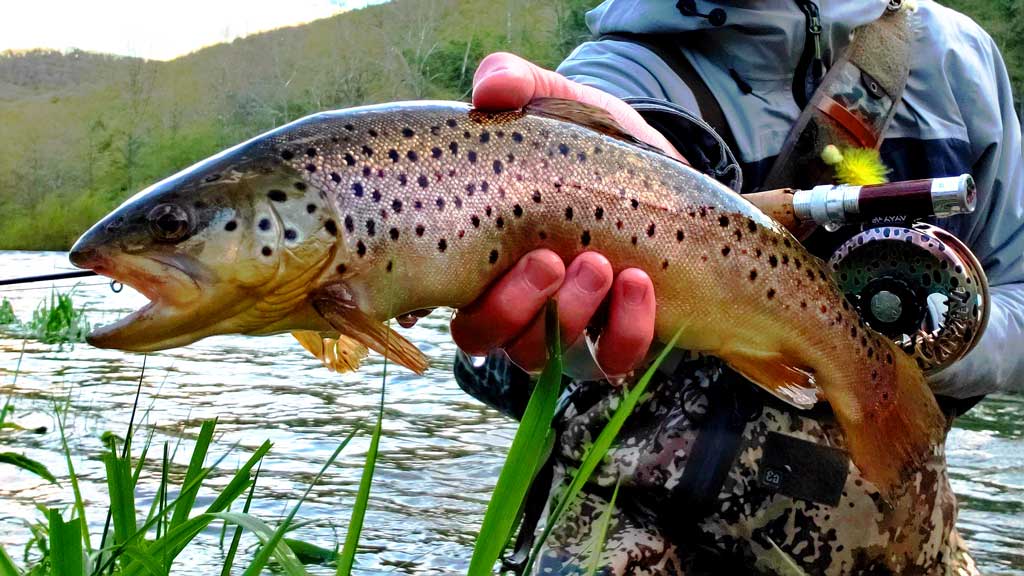Are you wondering how to fish streamers in a lake? You've come to the right place; we have a whole host of tips and information that'll ensure you learn how to fly fishing streamers in a lake successfully!
If you're looking to catch big fish - like trout - then fly fishing streamers can be one of the best ways to do just that. However, it provides a different experience from what you're used to. We will break everything down into twenty simple tips that'll transform your fishing experience in this guide.

How Do You Fish Streamers In A Lake?
Streamer Fly Fishing is a fly fishing method that uses an artificial pattern called a Streamer. Streamers are specifically designed to replicate minnows, baitfish, leaches and crayfish that trout and other predatory fish like to feed on. Using either a floating or sinking fly line and long leaders, streamers are cast from the bank or boat and retrieved back to the fly fisher to imitate these food sources and entice a take.
The benefit of using flies is that they appeal to trout and other big fish. Thanks to their designs, streamers will also mimic the movements of smaller fish in the water. As such, hungry trout will feel the water moving, they will see the fly underwater, and they'll go in for the kill. It's such an effective way of catching some big fish without needing life bait. The beauty of a streamer is that it can be used repeatedly to keep catching trout.
Naturally, the big question is, how do you fish streamers in a lake? More accurately, how do you do this successfully? Here are twenty tips that will help you get started:

#1 Streamer Fly Fish When The Water is Optimal
Optimal trout fly fishing water temperature is between 52 and 64 degrees Fahrenheit. Trout are actively feeding during this range. Trout are unlikely to rise to the surface when it's extremely hot or cold. So, finding the optimal temperature for the feeding zone will increase your chances at success.

#2 Use A Streamer In Murky Waters
Is the water in your lake very clear? If so, a streamer might not be the most practical as your retrieve will have to be spot on and the thicker tippet makes them relatively easy for trout to spot. Instead, they are super effective when used in murky waters. This makes it harder to detect your line, and the fish are more likely to attack.
#3 Smaller Streamers Work Better In Clear Water
Of course, what happens if your lake is clear and you can't find any murky water? This doesn't mean you need to give up and find somewhere else to fish completely. Instead, it would be best if you discovered smaller streamers that are subtler. This lets you use a smaller tippet, creating a more realistic baitfish for the trout to see. They will be less cautious, bringing more strikes to your line.

#4 Fish Streamers Near Cover
Always look for cover when targeting your streamers. There are a couple of reasons for this, the main one being that you will find much fish under banks and around other areas of cover. Simply put, this is a safer haven for them, free from any predators they might have. It's also an excellent place for fish like trout to hide as they wait for their prey to appear, stalking them without alerting them of their presence.
Ironically, the only prey they'll see in this instance is your fly. Sink it around areas of cover, and you immediately have a higher chance of getting a bite than if you fished your streamers in the middle of the lake.

#5 Fish Deep During Mid Day
As touched upon earlier, streamers work best when underwater and during the height of the day fish will be in the deeper parts of the lake. Deep areas of water during the day are excellent for two reasons:
- It's dark down there, so the fish can't see much, meaning your streamer can stand out.
- The biggest fish lurk in the depths, meaning you can get a serious catch on your hands.
The deeper you fish, the less competition there is for your streamer from real small fish. So, the big trout are going to spot your bait and swim straight towards it.

#6 Use Colorful Streamers as Attractors
You can find streamers with all sorts of designs and features that make them unique. Nevertheless, one pro tip is to use ones that are colorful and vibrant as attractors. Many are made with reflective materials that let them shine and flash while underwater. This is important as it helps draw attention to the streamer in the darker depths of the lake.

#7 Cast Your Flies As Far As Possible
When fly fishing flies for trout, you ideally want to cast your line as far as you possibly can. The exact technique you use will depend on the fly at the end, largely because of weight. Either way, you need to really load up the tension before casting and swing it as far as you can. It's a good job to wade upstream where you're fishing to cast, further maximizing the distance you get.
#8 Always Finish With Your Rod In The Air
When fly fishing streamers in a lake, an excellent tip is to finish your cast with the rod high in the air. You want it to be almost slap bang in the middle of 180 and 90 degrees, and there's a reason for it. As well as looking professional, having the rod high in the air like this will let you get some extra feet on the cast, but it also gives you more control over the fly as it drops. Thus, you can allow for a lighter drop into the water, avoiding any disturbances and not making all the fish scatter.

#9 Wait A Few Seconds After Your Fly Has Hit The Water
We keep banging on about depth, but it's such a critical thing to drill into your brain when fly fishing flies like these. Finding deep water is just one of the many ways in which you can encourage your streamers to go as deep as possible. Another tip is to count down to 20 seconds after your streamer touches the water to get it to deeper depths.
Pause and don't touch anything for a few seconds, letting the weight of it pull the streamer and line deeper into the water. In essence, you're waiting for the fly to drop as low as it can be, rather than adding in movement while it's too high up.

#10 Dead Drift Your Streamer
You will come across many tips in this guide that suggests different techniques to use when fishing streamers. One of these suggestions is to dead drift your streamer in the lake. This is usually reserved for other areas of fly fishing, but it works surprisingly well here too.
You want to drift your streamer to make it look like the bait is stunned or dead. In lakes, trout will often come across real fish that are stunned after battles with other fish or have died. It's ironically very realistic to make your streamer play dead, encouraging trout to come in for an easy dinner.

#11 Use Cone-Headed or Weighted Flies
Cone-headed or weighted flies are excellent streamers because they help you go deeper and deeper. The cone-headed flies are designed to be more dynamic in the water, cutting through to the depths with ease. However, weighted flies are still the best for deep areas as the added weight naturally helps them sink as deep as can be, getting you right next to the hungry predators.

#12 Use The Strip Set Technique
The strip set is perfect for this situation as it is used to replicate baitfish or crustacean patterns. Essentially, you're trying to make your streamer look as natural as possible in the water. You're stripping the fly back towards you, making it look like it is swimming. This, combined with the look of your streamer, is enough to get all the nearby trout interested. To them, it can look like a lonely little fish or crustacean swimming along with no protection.

#14 Small Strips for Smaller Streamers
When you start stripping, the best technique is to make little strips just a few inches. This is all that's needed to give a realistic replication of a baitfish. If you strip too large, you could scare off the predators or make them think something's not right. Small strips work the best and keep doing them until the fly is close to the end of its drift.
#15 Jig Your Fly Back To You
Jigging your fly is another excellent technique to use if you're struggling to get bites. Technically, it can be used at any stage when fly fishing streamers in a lake. Nevertheless, we deem it most necessary after the previous tip above. If your fly has been swinging and is now at the end of its swing, you should start jigging it and making larger strips to create more movement.
Do this, but throw in a pause now and then, slowly bringing the fly back to you for a second cast. At this moment, you could get a late bite as it looks like your bait is floundering. Trout may see it as an opportunity to attack a struggling fish, but little do they know you've planned this the whole time.

#16 Slow And Steady Wins The Race
Instinctively, you may think that a fast retrieve is the best approach with a streamer. After all, you want to mimic underwater life. However, a slower approach is much better as it gives the trout more time to notice your bait and react to it. By slowly retrieving, you can bait trout out from their hiding spots and get them slowly stalking their prey.
Think about it this way: you're increasing the time a trout has to spot your bait and strike. If you move too fast, it's over too soon, and there's less time for trout to attack. Not to mention the fact that too much speed can spook the trout away.
Also, factor in that this is lake fishing, not river or stream fishing. There's no rapid current, so fish will naturally move a lot slower and lazier. A slower retrieve is more realistic in this setting!

#17 Use A 5 Weight Or More Rod
The precise weight of your rod depends on the size of the fly, but anything from a five weight upwards will suffice in this scenario. The larger and heavier your flies, the heavier your rod should be. We can't stress enough how important this is, as you can easily snap your rod with a heavy streamer.

#18 Large Arbor Reels Work Best
A large arbor reel is ideal for fly fishing streamers as it lets you handle the weight of your rod and tackle the aggressive trout. You're targeting some big fish when you use flies, so you need a reel that can provide additional strength to reel them in.

#19 Utilize A Sinking Tip Line
It comes as no surprise that this is the preferred line to use in this scenario. Once again, this is because it will help you reach the lower depths of the water.
#20 Make Adjustments & Be Creative
Don't be afraid to get creative and modify your retrieval when fly fishing flies for trout in a lake. The best thing about streamers is that you're supposed to make them move a lot, meaning you can try different retrieval techniques if the initial one doesn't work.
Similarly, think about your cast as well. After the first one, make small adjustments and tackle a different patch of water on the lake. You don't need to get a bite straight away - it's about trial and error most of the time.

What Types Of Streamers Are Available?
You tend to have a few main categories to choose from:
Baitfish - These streamers are designed to mimic live bait and can be very attractive to trout. You will typically see them in the shape of minnows and leeches, but they can take many forms.
Leaches - These streamers are tied to mimic aquatic leaches. Leaches can be found in almost every body of water from ponds to the great lakes and are a staple food source for predatory trout.
Sculpins - The final category is designed to look like small fish typically found in shallow waters or ripples. Trout love sculpins, which is why they're used quite often to lure them in.
For more information on how to fly fish with a sculpin pattern check out this article >
What Color Streamer Should You Choose?
One of our twenty tips explained that you should use colorful streamers to attract any hidden trout in the water. However, what color streamers should you choose, and do some work better than others?
There are so many different colors and patterns available to answer this question, all of which have their place in the fly fishing world. Typically, choosing the right color depends on:
- The water clarity
- The amount of sunlight you're getting
- How deep you can sink the fly
As general guidance, darker streamers work best in darker waters on darker days. Purple or black are the two colors most people choose here because they provide an excellent silhouette that makes them stand out. Likewise, on brighter days, you need a lighter streamer that can reflect the sun and almost sparkle in the water, attracting lots of attention.

Why Use Streamers When Fly Fishing For Trout?
You've gathered all of this information on how to fish streamers in a lake, but why is this such an effective fishing method?
Cast your mind back to the start of this guide, and we spoke about how the design of streamers appeals to trout by looking like natural food sources. However, some streamers don't look anything like a trout's food yet can still catch them.
One hypothesis is that the movement of streamers triggers a natural response in the trout. They are reflexively acting when they see something wiggle or feel a change in the water nearby. Regardless of what the streamer looks like, the fish see something that they can eat, and they go for it. You're triggering the natural predatorial instinct of the trout, forcing them to come for a bite. Before they've realized their mistake, you can start reeling them in.
Follow all of the advice in this guide if you want to get better at fly fishing streamers in a lake. The tips we've provided will help you get started and refine your technique, making your next trout fishing trip an effective one.
About the Author
Matthew Bernhardt, a third-generation Coloradan, grew up at the forefront of the state’s fly-fishing revolution, enjoying time on the water, side by side with experienced guides and lifelong anglers.
By combining his passion for fly-fishing with input from other experienced fly-fishers and guides and his fine arts degree from Colorado State University, Matthew spent five years carefully developing the Drifthook Fly Fishing System, built to help every angler catch more trout.
When he’s not spending time with his wonderful family, you’ll find him out on the water catching MONSTER trout, and he anxiously looks forward to the day when his kids are old enough to join him there.






